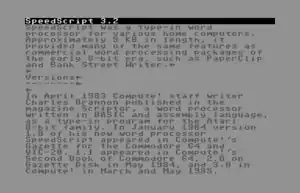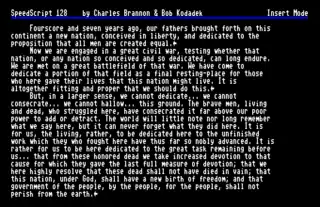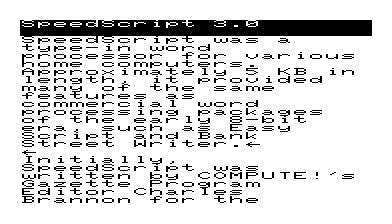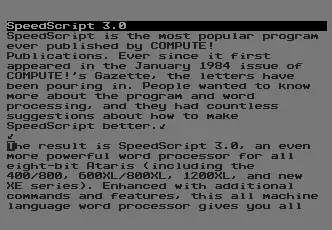SpeedScript
SpeedScript is a word processor originally printed as a type-in machine language listing in 1984-85 issues of Compute! and Compute!'s Gazette magazines. Approximately 5 KB in length, it provided many of the same features as commercial word processing packages of the 8-bit era, such as PaperClip and Bank Street Writer. Versions were published for the Apple II, Commodore 64 and 128, Atari 8-bit family, VIC-20, and MS-DOS.
 SpeedScript 3.2 on a Commodore 64 | |
| Original author(s) | Charles Brannon |
|---|---|
| Developer(s) | Compute! Publishing |
| Initial release | January 1984[1] |
| Stable release | 3.2
/ May 1987[2] |
| Written in | 6502 assembly language,[1] Turbo Pascal[3] (MS-DOS) |
| Platform | VIC-20, Commodore 64 / 128, Apple II, Atari 8-bit, MS-DOS |
| Type | Word processor |
Versions
In April 1983 Compute! published Scriptor, a word processor written by staff writer Charles Brannon in BASIC and assembly language, as a type-in program for the Atari 8-bit family.[4] In January 1984 version 1.0 of his new word processor SpeedScript appeared in Compute!'s Gazette for the Commodore 64 and VIC-20.[1] 1.1 appeared in Compute!'s Second Book of Commodore 64, 2.0 on Gazette Disk in May 1984, and 3.0 in Compute! in March and April 1985.[5][6] Corrections that updated 3.0 to 3.1 appeared in May 1985,[7] and the full version appeared in a book published by Compute!, SpeedScript: The Word Processor for the Commodore 64 and VIC-20.[8] A 3.2 update appeared in the December 1985 Compute![9] and January 1986 Compute! Disk[2] and again later in the May 1987 Compute!'s Gazette issue with three additional utilities.[10]
Ports to the Atari and the Apple II were printed in Compute! in May[11] and June 1985 respectively.[12][2] SpeedScript was written entirely in assembly language, and Compute! Publications later released book/disk combinations that contained the complete commented source code (as well as the machine language in MLX format) for each platform.[8][13][14]
A version of SpeedScript for MS-DOS was created in 1988 by Randy Thompson and published in book form by Compute! Books.[3] This version was written in Turbo Pascal with portions written in assembly language, and added incremental new features to the word processor such as additional printer commands, full cursor-control (to take advantage of the PC's Home, End, PgUp, and PgDn keys), and a native 80-column mode.
80-column updates
The original versions of SpeedScript were designed for the 40-column Commodore 64 and the 22-column VIC-20. When the Commodore 128 was released, featuring an 80-column display, many users requested an updated version of SpeedScript to take advantage of this new capability. In June 1986, Compute!'s Gazette published SpeedScript-80, a short patch for SpeedScript 3.0 or higher, which enabled the use of the VDC's new 80-column capabilities on a Commodore 128 running in 64 mode.[15] However, this did not take advantage of the C128's expanded memory, and a few minor commands were eliminated due to the alterations to the existing code. SpeedScript-80 was enhanced soon after with SpeedScript-80 Revisited, by Bob Kodadek.

A native version for the C128 called SpeedScript 128, also written by Kodadek, was finally released in October 1987. This version eliminated the problems of the patch and took full advantage of the C128's 80-column screen, its expanded memory and the enhanced keyboard.[16] A later update appeared in September 1989, adding full text justification, tab setting, and online help.[17]
In December 1987, Compute!'s Gazette published Instant 80, a utility for the C64 version of SpeedScript that allowed 80-column document previewing (though not editing) on a standard C64. This was done by using half-width characters on a high-resolution graphics screen.[18]
Utilities
Although SpeedScript did not include a built-in spell checker, additional utilities were soon published. In December 1985, SpeedCheck was published in Compute!'s Gazette.[19] This external utility accepted SpeedScript files (as well as those from compatible word processors, such as PaperClip) and spell-checked them against a user-defined dictionary. An enhanced 80-column version for the C128, SpeedCheck 128, was published in September 1988.[20]
Another utility, ScriptSave, was developed to provide automatic saving functionality to the Commodore 64 version of SpeedScript 3.0.[21] This program would set up a timer program to save documents to disk, before loading and running SpeedScript itself.
Several additional utilities were published in the May 1987 issue of Compute!'s Gazette along with SpeedScript 3.2. ScriptRead[22] was developed to identify and preview SpeedScript documents on a disk, with the ability to scratch any files no longer needed. This was an important addition as on a single-drive system there would be no way to save work if the disk became full. SpeedSearch[23] provided full-text search of all SpeedScript documents on a disk, returning a count of how many times the searched word or phrase was used in each document. Date and Time Stamper[24] introduces a program to the disk drive that adds time stamps to files on disk, then executes SpeedScript.
Reception
In a review of four word processors, The Transactor in May 1986 praised SpeedScript as "extremely sophisticated", citing its large text buffer, logical cursor navigation, and undo command. While criticizing its lack of right justification, the magazine concluded that SpeedScript was not only "an easy winner" among budget-priced word processors, but also "a serious contender even when compared with the higher priced programs".[25]
SpeedScript was sufficiently popular to receive coverage in reference works, such as the "Wordprocessing Reference Guide" of Karl Hildon's Inner Space Anthology[26] and Mitchell Waite's The Official Book for the Commodore 128.[27] Columbia University's Kermit software for Commodore computers supported transferring SpeedScript files.[28]
Gallery


References
- Brannon, Charles (January 1984). "SpeedScript Word Processor For Commodore 64 And VIC-20". COMPUTE!'s Gazette. Greensboro, North Carolina: COMPUTE! Publications (7): 38–59. Retrieved 18 February 2015.
- Mitchener, Leo (June 1986). "SpeedScript's Lineage". COMPUTE! (Letters to the Editor) (73): 11. ISSN 0194-357X. Retrieved 8 November 2013.
- Thompson, Randy (1989). PC SpeedScript. Radnor, Pennsylvania: COMPUTE! Books. ISBN 0-87455-166-8.
- Brannon, Charles (April 1983). "Scriptor: An Atari Word Processor". COMPUTE! (35): 56–70. ISSN 0194-357X. Retrieved 30 October 2013.
- Brannon, Charles (March 1985). "SpeedScript 3.0: All Machine Language Word Processor For Commodore 64". COMPUTE! (58): 123–133. ISSN 0194-357X. Retrieved 1 March 2015.
- Brannon, Charles (April 1985). "SpeedScript 3.0: All Machine Language Word Processor For Expanded VIC-20". COMPUTE! (59): 100–106. ISSN 0194-357X. Retrieved 1 March 2015.
- "Capute!". COMPUTE! (Column) (60): 99. May 1985. ISSN 0194-357X. Retrieved 1 March 2015.
- Brannon, Charles (1985). SpeedScript, the Word Processor for the Commodore 64 and VIC-20. Greensboro, North Carolina: COMPUTE! Publications. ISBN 0-94238-694-9.
- Brannon, Charles (December 1985). "SpeedScript 3.0 Revisited". COMPUTE! (67): 90–91. ISSN 0194-357X. Retrieved 1 March 2015.
- Brannon, Charles (May 1987). "SpeedScript 3.2 For The Commodore 64". COMPUTE!'s Gazette (47): 54–71. ISSN 0737-3716. Retrieved 1 March 2015.
- Brannon, Charles (May 1985). "SpeedScript 3.0: All Machine Language Word Processor For Atari". COMPUTE! (60): 103–111. ISSN 0194-357X. Retrieved 1 March 2015.
- Brannon, Charles; Martin, Kevin (June 1985). "SpeedScript 3.0: All Machine Language Word Processor For Apple". COMPUTE! (61): 116–123. ISSN 0194-357X. Retrieved 1 March 2015.
- Brannon, Charles (1985). SpeedScript, the Word Processor for Atari Computers. Greensboro, North Carolina: COMPUTE! Publications. ISBN 0-87455-003-3.
- Brannon, Charles; Martin, Kevin (1985). Speedscript, the Word Processor for Apple Personal Computers. Greensboro, North Carolina: COMPUTE! Publications. ISBN 0-87455-000-9.
- Heimarck, Todd (June 1986). "SpeedScript-80 For The 128". COMPUTE!'s Gazette (36): 77–78. ISSN 0737-3716. Retrieved 1 March 2015.
- Kodadek, Robert (October 1987). "SpeedScript 128". COMPUTE!'s Gazette (52): 22–52. ISSN 0737-3716. Retrieved 1 March 2015.
- Gruber, Michael (September 1989). "SpeedScript 128 Plus". COMPUTE!'s Gazette (75): 38–44. ISSN 0737-3716. Retrieved 4 March 2015.
- Mackinnon, Glen (December 1987). "Instant 80: True 80-Column Preview For SpeedScript". COMPUTE!'s Gazette (54): 76. ISSN 0737-3716. Retrieved 1 March 2015.
- Cowper, Ottis T. (December 1985). "SpeedCheck: An Expandable Spelling Checker For The Commodore 64 And 128". COMPUTE!'s Gazette (30): 64–70. ISSN 0737-3716. Retrieved 18 February 2015.
- Smith, Larry D (September 1988). "SpeedCheck 128: A Spelling Checker For SpeedScript 128". COMPUTE!'s Gazette (63): 60–61. ISSN 0737-3716. Retrieved 1 March 2015.
- Lambert, J. Blake (May 1985). "ScriptSave: Automatic Disk Saves For Commodore 64 SpeedScript 3.0". COMPUTE! (60): 84–85. ISSN 0194-357X. Retrieved 1 March 2015.
- Childress, Buck (May 1987). "ScriptRead". COMPUTE!'s Gazette (47): 77. ISSN 0737-3716. Retrieved 18 February 2015.
- St. Clair, Tony (May 1987). "SpeedSearch". COMPUTE!'s Gazette (47): 75. ISSN 0737-3716. Retrieved 18 February 2015.
- Kodadek, Bob (May 1987). "SpeedScript Date and Time Stamper". COMPUTE!'s Gazette (47): 76. ISSN 0737-3716. Retrieved 18 February 2015.
- Bose, Ranjan (May 1986). "A Comparison of Four Word Processors". The Transactor. 6 (6): 72–74. ISSN 0827-2530. Retrieved 1 March 2015.
- Hildon, Karl J. H. (March 1985). The Complete Commodore Inner Space Anthology. Milton, Ontario: Transactor Publishing. pp. 17–19. ISBN 0-9692086-0-X. Retrieved 1 March 2015.
- Waite, Mitchell; Lafore, Robert; Volpe, Jerry (1985). "The C64 Mode". The Official Book for the Commodore 128 Personal Computer. Howard W. Sams & Co. p. 76. ISBN 0-672-22456-9.
- Sullivan, Kent (1 January 1992). "File Transfers: Transferring Files". Commodore 64/128 Kermit User's Guide. Kermit Project, Columbia University. p. 18. Retrieved 23 February 2016.
